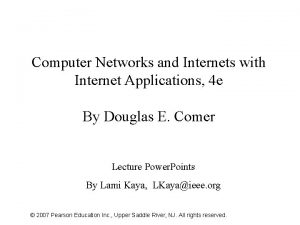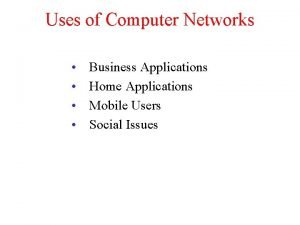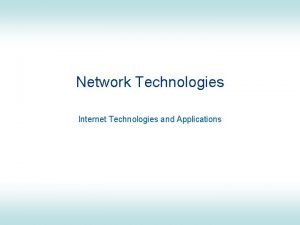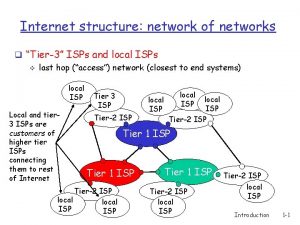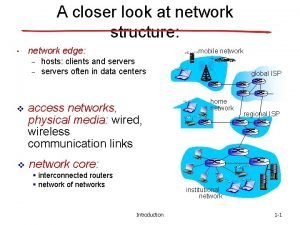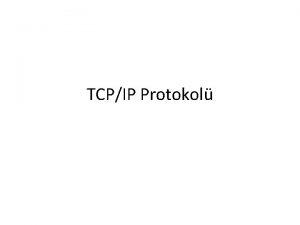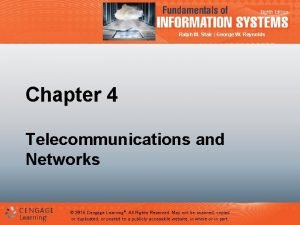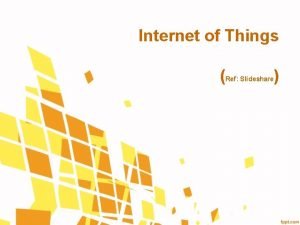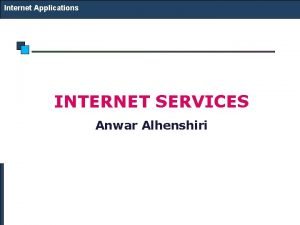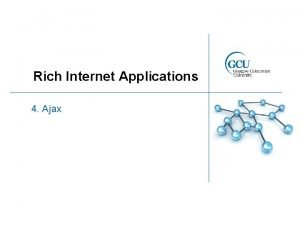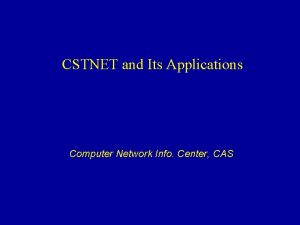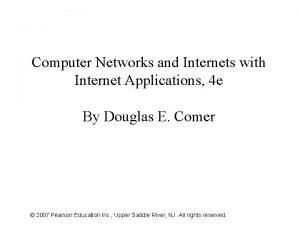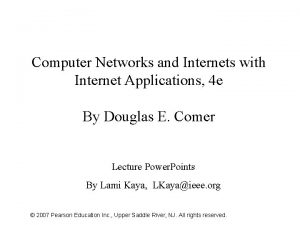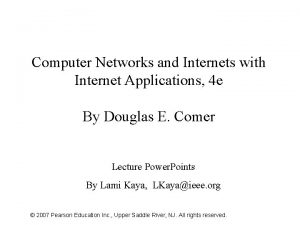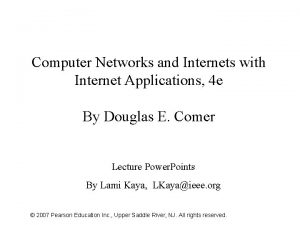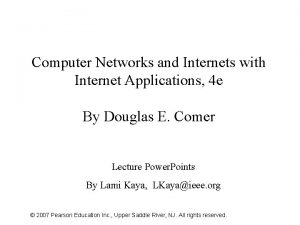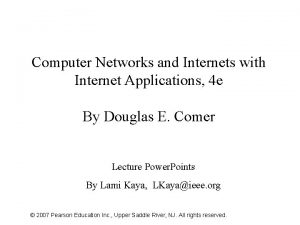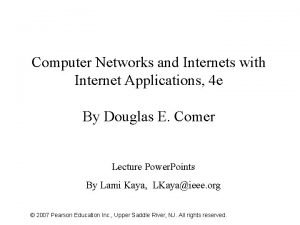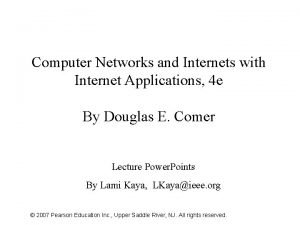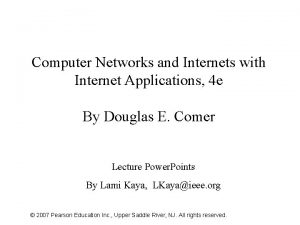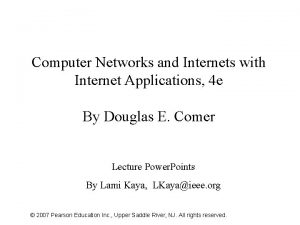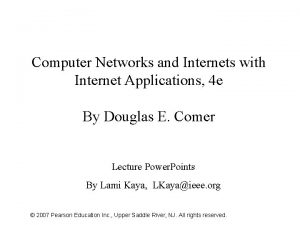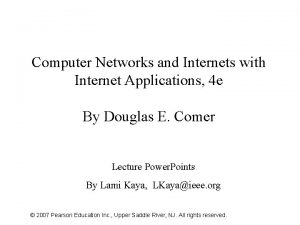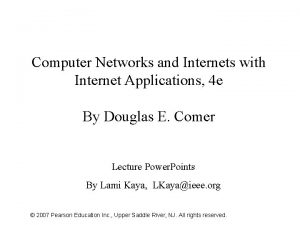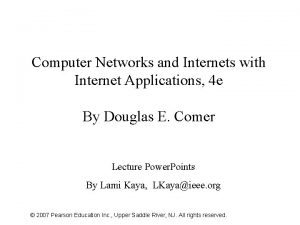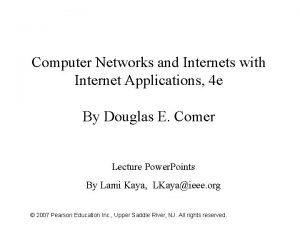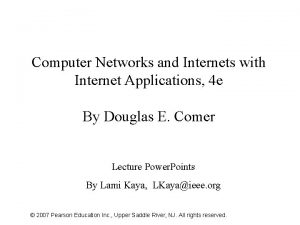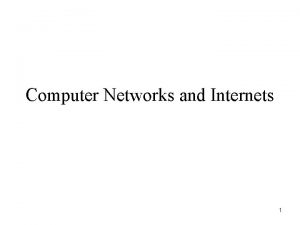Computer Networks and Internets with Internet Applications 4


































- Slides: 34

Computer Networks and Internets with Internet Applications, 4 e By Douglas E. Comer Lecture Power. Points By Lami Kaya, LKaya@ieee. org © 2007 Pearson Education Inc. , Upper Saddle River, NJ. All rights reserved.

Chapter 3 Network Programming and Applications © 2007 Pearson Education Inc. , Upper Saddle River, NJ. All rights reserved.

Topics Covered • • 3. 1 Introduction 3. 2 Network Communication 3. 3 Client-Server Computing 3. 4 Communication Paradigm 3. 5 An Example Application Program Interface 3. 6 An Intuitive Look At The API 3. 7 Definition Of The API – – – – 3. 7. 1 The Await_Contact Function 3. 7. 2 The Make_Contact Function 3. 7. 3 The Appname_To_Appnum Function 3. 7. 4 The Cname_To_Comp Function 3. 7. 5 The Send Function 3. 7. 6 The Recv And Recvln Functions 3. 7. 7 The Send_Eof Function 3. 7. 8 Summary Of API Types © 2007 Pearson Education Inc. , Upper Saddle River, NJ. All rights reserved.

Topics Covered (cont) • 3. 8 Code For An Echo Application – 3. 8. 1 Example Echo Server Code – 3. 8. 2 Example Echo Client Code • 3. 9 Code For A Chat Application – 3. 9. 1 Example Chat Server Code – 3. 9. 2 Example Chat Client Code • 3. 10 Code For A Web Application – 3. 10. 1 Example Web Client Code – 3. 10. 2 Example Web Server Code • 3. 11 Managing Multiple Connections With The Select Function © 2007 Pearson Education Inc. , Upper Saddle River, NJ. All rights reserved.

3. 1 Introduction This chapter • describes NW from a programmer's point of view • outlines the NW facilities available to a programmer • examines example applications that use a NW • introduces a small set of library functions • shows how the library functions can be used This chapter will demonstrate an important idea: • A programmer can create Internet applications – without understanding the underlying NW technology or communication protocols © 2007 Pearson Education Inc. , Upper Saddle River, NJ. All rights reserved.

3. 2 Network Communication • When applications use a NW, they do so in pairs – The pair uses the NW merely to exchange messages • Ex: imagine a distributed database service that allows remote users to access a central database • Such a service requires two applications, – one running on the computer that has the database – and the other running on a remote computer • The application on the remote computer sends a request to the application running on the database computer – When the request arrives, the application running on the database computer consults the database and returns a response • Only the two applications understand the message format and meaning © 2007 Pearson Education Inc. , Upper Saddle River, NJ. All rights reserved.

3. 3 Client-Server Computing (1) • One application starts first and waits for the other application to contact it • The second application must know the location where the first application is waiting • The arrangement in which a NW application waits for contact from another application is known as the – client-server paradigm or client-server computing • The program that waits for contact is called a server • The program that initiates contact is known as a client – To initiate contact, a client must know where the server is running, and must specify the location © 2007 Pearson Education Inc. , Upper Saddle River, NJ. All rights reserved.

3. 3 Client-Server Computing (2) How does a client specify the location of a server? • In the Internet, a location is given by a pair of identifiers – (computer, application) • computer identifies the computer on which the server is running • application identifies a particular application program on that computer • Application SW represents the two values as binary numbers • Humans never need to deal with the binary representation directly – Instead, the values are also given alphabetic names • Humans enter the names, and software translates each name to a corresponding binary value automatically © 2007 Pearson Education Inc. , Upper Saddle River, NJ. All rights reserved.

3. 4 Communication Paradigm • Two applications – establish communication, – exchange messages back and forth, – and then terminate • The steps (in details) are: – The server starts first, and waits for contact from a client – The client specifies the server's location and requests a connection be established – Once a connection is in place, the client and server use the connection to exchange messages – After they finish sending data, the client and server each send an end-of-file (EOF) and the connection is terminated © 2007 Pearson Education Inc. , Upper Saddle River, NJ. All rights reserved.

3. 5 An Example Application Program Interface • Application Program Interface (API) is used to describe the set of operations available to a programmer • The API specifies the arguments for each operation as well as the semantics • Figure 3. 1 lists the seven functions that an application call – Functions send and recv are supplied directly by the OS – Other functions in the API consist of routines that are written – These seven functions are sufficient for most NW applications © 2007 Pearson Education Inc. , Upper Saddle River, NJ. All rights reserved.

© 2007 Pearson Education Inc. , Upper Saddle River, NJ. All rights reserved. 11

3. 6 An Intuitive Look At The API • A server begins by calling await_contact to wait for contact from a client • The client begins by calling make_contact to establish contact • Once the client has contacted the server – the two can exchange messages with send and recv • The two applications must be programmed – to know whether to send or receive – if both sides try to receive without sending, they will block forever • After it finishes sending data, an application calls send_eof to send the EOF • On the other side, recv returns a value of zero to indicate that the EOF has been reached • Figure 3. 2 illustrates the sequence of API calls that the client and server make for such an interaction © 2007 Pearson Education Inc. , Upper Saddle River, NJ. All rights reserved.

© 2007 Pearson Education Inc. , Upper Saddle River, NJ. All rights reserved. 13

3. 7 Definition Of The API • To keep our API independent of particular OS and NW software – we can define three data types and use • Figure 3. 3 lists the type names and their meanings – Using the three types, we can precisely define the example API © 2007 Pearson Education Inc. , Upper Saddle River, NJ. All rights reserved.

© 2007 Pearson Education Inc. , Upper Saddle River, NJ. All rights reserved. 15

Await_Contact Function • A server calls function await_contact to wait for contact from a client connection await_contact(appnum a) • The call takes one argument of type appnum and returns a value of type connection – The argument specifies a number that identifies the server application – a client must specify the same number when contacting the server • The server uses the return value (type connection ) to transfer data © 2007 Pearson Education Inc. , Upper Saddle River, NJ. All rights reserved.

Make_Contact Function • A client calls function make_contact to establish contact with a server connection make_contact (computer c, appnum a) • The call takes two arguments – identify a computer on which the server is running – and the application number that the server • The client uses the return value – which is of type connection to transfer data © 2007 Pearson Education Inc. , Upper Saddle River, NJ. All rights reserved.

Appname_To_Appnum Function • Clients and servers both use appname_to_appnum – to translate from a human-readable name for a service to an internal binary value • The service names are standardized throughout the Internet appnum appname_to_appnum(char *a) • The call takes one argument and returns an equivalent binary value of type appnum © 2007 Pearson Education Inc. , Upper Saddle River, NJ. All rights reserved.

Cname_To_Comp Function • Clients call cname_to_comp – to convert from a human-readable computer name to the internal binary value computer cname_to_comp (char *c) • The call takes one argument and returns an equivalent binary value of type computer © 2007 Pearson Education Inc. , Upper Saddle River, NJ. All rights reserved.

Send Function • Both clients and servers use send to transfer data across the network int send (connection con, char *buffer, int length, int flags) • The call takes four arguments. – The first argument specifies a connection previously established with await_contact or make_contact – the second is the address of a buffer containing data to send – the third argument gives the length of the data in bytes (octets) – and the fourth argument is zero for normal transfer • Send returns the number of bytes transferred, or a negative value if an error occurred © 2007 Pearson Education Inc. , Upper Saddle River, NJ. All rights reserved.

Recv And Recvln Functions • Both clients and servers use recv to access data that arrives int recv (connection con, char *buffer, int length, int flags) • The call takes four arguments – – The first specifies a connection with await_contact or make_contact the second is the address of a buffer into which the data to be placed the third gives the size of the buffer in bytes and the fourth is zero for normal transfer • recv returns the number of bytes that were placed in the buffer – zero to indicate that EOF has been reached – or a negative value to indicate that an error occurred • We can also use a library function recvln that repeatedly calls recv until an entire line of text has been received. int recvln (connection con, char *buffer, int length) © 2007 Pearson Education Inc. , Upper Saddle River, NJ. All rights reserved.

Send_Eof Function • Both the client and server must use send_eof after sending data – to inform the other side that no further transmission will occur • On the other side, the recv function returns zero when it receives the EOF int send_eof(connection con) • Argument specifies a connection previously established with await_contact or make_contact • The function returns a negative value – to indicate that an error occurred, and a non-negative value otherwise © 2007 Pearson Education Inc. , Upper Saddle River, NJ. All rights reserved.

© 2007 Pearson Education Inc. , Upper Saddle River, NJ. All rights reserved. 23

3. 8 Code For An Echo Application (1) • The client repeatedly – prompts the user for a line of input, – sends the line to the server, – and then displays whatever the server sends back. • Like all the applications described in this chapter, – the echo application operates across a NW – That is, the client and server programs can run on separate computers • Figure 3. 5 illustrates connection to the Internet © 2007 Pearson Education Inc. , Upper Saddle River, NJ. All rights reserved.

© 2007 Pearson Education Inc. , Upper Saddle River, NJ. All rights reserved. 25

3. 8 Code For An Echo Application (2) • Ex: suppose someone using computer lancelot. cs. purdue. edu chooses 20000 as the application number • The server is invoked by the command: echoserver 20000 • If some other application is using number 20000, – the server emits an appropriate error message and exits – the user must choose another number. • Once the server has been invoked, the client is invoked: echoclient lancelot. cs. purdue. edu 20000 © 2007 Pearson Education Inc. , Upper Saddle River, NJ. All rights reserved.

3. 9 Code For A Chat Application • A simplified version of chat that works between a single pair of users • One user begins by choosing an application number and running the server • Ex: suppose a user on excalibur. cs. purdue. edu runs the server: chatserver 25000 • A user on another computer can invoke the client: chatclient excalibur. cs. purdue. edu 25000 • To keep the code as small as possible – the scheme requires users to take turns entering text – Users alternate entering text until one of them sends an EOF © 2007 Pearson Education Inc. , Upper Saddle River, NJ. All rights reserved.

3. 10 Code For A Web Application (1) • To run the server, a user chooses an application number and invokes the server • Ex: if a user on computer netbook. cs. purdue. edu chooses application number 27000, the server can be invoked with the command: webserver 27000 • The client specifies a computer, a path name, and an application number: webclient netbook. cs. purdue. edu /index. html 27000 • It is possible to use a conventional Web browser (such as, Internet Explorer or Netscape) to access the server http: //netbook. cs. purdue. edu: 27000/index. html © 2007 Pearson Education Inc. , Upper Saddle River, NJ. All rights reserved.

3. 10 Code For A Web Application (2) • The client code is extremely simple: – after establishing communication with the Web server, it sends a request, which must have the form : GET / path HTTP/1. 0 CRLF GET – where path denotes the name of an item such as index. html , – CRLF denotes the two characters carriage return and line feed. • After sending the request, the client receives and prints output from the server © 2007 Pearson Education Inc. , Upper Saddle River, NJ. All rights reserved.

3. 10 Code For A Web Application (3) • Web server may seem more complex than previous examples, – complexity results from Web details rather than networking details • In addition to reading and parsing a request – the server must send both a ``header'' and data in the response – The header consists of several lines of text that are terminated by CRLF • The header lines are of the form: HTTP/1. 0 status_string CRLF Server: CNAI Demo Server CRLF Content-Length: datasize CRLF Content-Type: text/html CRLF • where datasize denotes the size of the data that follows © 2007 Pearson Education Inc. , Upper Saddle River, NJ. All rights reserved.

3. 10 Code For A Web Application (4) • The code is also complicated by error handling – error messages must be sent in a form that a browser can understand • If a request is incorrectly formed, our server generates a 400 error message • If the item specified in the request cannot be found 404 error message • The Web server differs from the previous examples in a significant way: – the server program does not exit after satisfying one request – Instead, it remains running, ready for additional requests © 2007 Pearson Education Inc. , Upper Saddle River, NJ. All rights reserved.

3. 11 Managing Multiple Connections With The Select Function (1) • Although our example API supports 1 -to-1 interaction between a client and server, – the API does not support 1 -to-many interaction • To see why, consider multiple connections – To create such connections • a single application must call make_contact multiple times • specifying a computer and appnum for each call • Once the connections have been established – the application cannot know which of them will receive a message first © 2007 Pearson Education Inc. , Upper Saddle River, NJ. All rights reserved.

3. 11 Managing Multiple Connections With The Select Function (2) • Many OS include a function named select that solves the problem of managing multiple connections – The select call checks a set of connections – The call blocks until at least one of the specified connections has received data – The call then returns a value that tells which of the connections have received data © 2007 Pearson Education Inc. , Upper Saddle River, NJ. All rights reserved.

3. 11 Managing Multiple Connections With The Select Function (3) • Ex: consider an application that must receive requests and send responses over two connections – Such an application can have the following general form: Call make_contact to form connection 1; Call make_contact to form connection 2; Repeat forever { Call select to determine which connection is ready If (connection 1 is ready) { Call recv to read request from connection 1; Compute response to request; Call send to send response over connection 1; } if (connection 2 is ready) { Call recv to read request from connection 2; Compute response to request; Call send to send response over connection 2; } } © 2007 Pearson Education Inc. , Upper Saddle River, NJ. All rights reserved.
 Computer networks and internets with internet applications
Computer networks and internets with internet applications Computer networks and internets
Computer networks and internets Example of virtual circuit network
Example of virtual circuit network Compare internets
Compare internets Backbone networks in computer networks
Backbone networks in computer networks Uses of computer in business
Uses of computer in business Principles of network applications in computer networks
Principles of network applications in computer networks Business application in computer network
Business application in computer network Business application in computer network
Business application in computer network Internet transport protocol in computer networks
Internet transport protocol in computer networks Aim lans
Aim lans Tier 3 isps
Tier 3 isps Internet structure network of networks
Internet structure network of networks The internet is a combination of networks glued together by
The internet is a combination of networks glued together by Osi vs tcp/ip
Osi vs tcp/ip Intserv vs diffserv
Intserv vs diffserv Checksum in computer networks with example
Checksum in computer networks with example Byte stuffing example
Byte stuffing example Dle stx
Dle stx What is the reverse request protocol
What is the reverse request protocol Analogue and digital transmission in computer networks
Analogue and digital transmission in computer networks Web and http in computer networks
Web and http in computer networks Error correction in computer networks
Error correction in computer networks Protocols and standards in computer networks
Protocols and standards in computer networks Error correction in computer networks
Error correction in computer networks Applications of internet
Applications of internet Internet of things applications ppt
Internet of things applications ppt Applications of internet
Applications of internet Applications of internet
Applications of internet Rich internet applications with ajax
Rich internet applications with ajax Nhpce
Nhpce Internet or internet
Internet or internet Crc in computer networks
Crc in computer networks Crc in computer networks
Crc in computer networks Traffic management in computer networks
Traffic management in computer networks

